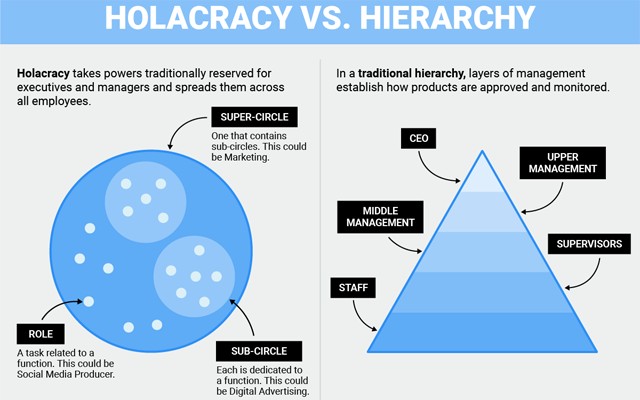BEC高级商务英语阅读文章精选:不需要老板领导的公司(一家没有CEO的公司该如何运转?)
导读:随着社会的不断进步,很多刚起步或者说规模不大的公司都在倡导扁平化管理。不过,你见过一家没有老板;员工自主管理、平起平坐的公司吗?反正我没有,至少在国内没有找到先例。事实上,不需要老板(或者说是决策人)的公司在国外还真有做得像模像样的。
以下文章选自BBC商业周刊,本文针对瑞典的一家软件咨询公司Crisp目前的运营现状,探讨没有CEO的公司是如何进行运作的。重点生词及实用短语已用蓝色高亮,希望能够对正在BEC备考的童鞋有所帮助。
Do you really need someone to tell you what to do at work?
Three years ago, Swedish software consultancy Crisp decided that the answer was no.
The firm, which has about 40 staff, had already trialled various organisational structures, including the more common practice of having a single leader running the company.
Crisp then tried changing its chief executive annually, based on a staff vote, but eventually decided collectively that no boss was needed.
Yassal Sundman, a developer at the firm, explains: “We said, ‘what if we had nobody as our next CEO – what would that look like?’ And then we went through an exercise and listed down the things that the CEO does.”
The staff decided that many of the chief executive’s responsibilities overlapped with those of the board, while other roles could be shared among other employees.
“When we looked at it we had nothing left in the CEO column, and we said, ‘all right, why don’t we try it out?'” says Ms Sundman.
Crisp holds four-day meetings for all staff two to three times a year. They are used to making decisions on issues that affect everyone, such as an office move, but workers are encouraged to make decisions themselves at other times.
It also still has a board – a legal requirement – and this can be used as a last resort to resolve issues if something is not working.
Henrik Kniberg, an organisational coach at the firm, argues that not having to ask a boss for decisions on projects or budgets means the firm can respond faster.
“If you want to get something done, you stand up and start driving that,” he says.
Yet Mr Kniberg stresses that not having to ask permission does not remove the need for staff to discuss issues or bounce ideas off each other.
Because they are all in charge, workers are more motivated, he argues. Crisp regularly measures staff satisfaction, and the average is about 4.1 out of five.
The company is set up like a family, says Mr Kniberg. While nobody tells anyone exactly what to do, the unspoken understanding is that you don’t mess up the house.
But what if the rest of the staff feel that one worker has made a terrible decision?
Ms Sundman says that is okay. “At least you did the thing that was right in the moment – and then we can have a discussion about it. You can explain why it is that you thought this was a good way, and actually you might get everybody else to think the same way.”
Ultimately, the firm hopes that its way of working could inspire other companies to emulate the “Crisp DNA”.
Although Crisp’s move may seem radical, plenty of companies have trialled a similar arrangement. One of the best-known is online shoe and clothing retailer Zappos, which is owned by Amazon.
In 2013 the firm adopted a new management structure called “holacracy”, which was intended to eliminate workplace hierarchy and foster collaboration.
However, almost a fifth of Zappos staff subsequently departed, with chief executive Tony Hsieh admitting that “self-management is not for everyone”.
While there is a growing trend for flatter organisational structures – meaning fewer middle managers and bosses – most of the more radical experiments are taking place in small start-ups.
As well as employing fewer people, such firms do not have the long corporate history that can make major changes much more difficult to implement.
Drew Houston, founder of online file-sharing service Dropbox, does not believe a leaderless structure can work in larger firms because it would be too chaotic.
The main risk, he says, is that staff will encroach into each other’s areas of responsibility, making them less efficient.
“Often infinite freedom like that can be pretty disorientating. It doesn’t always feel good, because you no longer know what you’re supposed to do, what’s important and you’re bumping up against other people,” Mr Houston says.
Similarly, Meg Whitman, chief executive of technology giant Hewlett Packard Enterprise (HPE), firmly believes that companies need a leader.
“You’ve got to have the accountability, because if people in your organisation don’t know what they’re doing and how it affects the customers, then you’ve got a disconnect problem,” she says.
However, HPE has tackled one problem that hinders many big companies: the time it takes to make decisions.
“We tended to let decisions sit for way too long a time,” Ms Whitman says. “So we now have a little saying at Hewlett Packard Enterprise: you’ve got to escalate a decision or a challenge and you have to resolve it in 48 hours.”
CEO coach and author Steve Tappin says even if firms are sceptical of companies that don’t have a single boss, it is worth paying attention to the likes of Crisp.
“Many businesses may not want to go as far as getting rid of their chief executive, but there are valid lessons to be learnt from radical companies like Crisp,” he says.

未经允许不得转载:商务英语学习网站-BEC备考网 » BEC高级商务英语阅读:不需要老板的公司
 商务英语学习网站-BEC备考网
商务英语学习网站-BEC备考网 BEC高级阅读文章精选:人才招聘智能化
BEC高级阅读文章精选:人才招聘智能化 BEC高级阅读文章精选:商业道德与慈善
BEC高级阅读文章精选:商业道德与慈善 BEC高级阅读文章精选:办公室幽默
BEC高级阅读文章精选:办公室幽默 BEC高级阅读精选:一镑店所属公司股价暴跌
BEC高级阅读精选:一镑店所属公司股价暴跌 BEC高级真题第五辑听力中英对照视频合集
BEC高级真题第五辑听力中英对照视频合集 BEC高级阅读文章精选:你有工作倦怠症吗?
BEC高级阅读文章精选:你有工作倦怠症吗? BEC高级真题第四辑听力中英对照视频合集
BEC高级真题第四辑听力中英对照视频合集 2017年BEC备考商务英语高级真题及答案
2017年BEC备考商务英语高级真题及答案 BEC中高级真题听力MP3音频汇总
BEC中高级真题听力MP3音频汇总 适合商务英语学习的电影及电视剧推荐
适合商务英语学习的电影及电视剧推荐